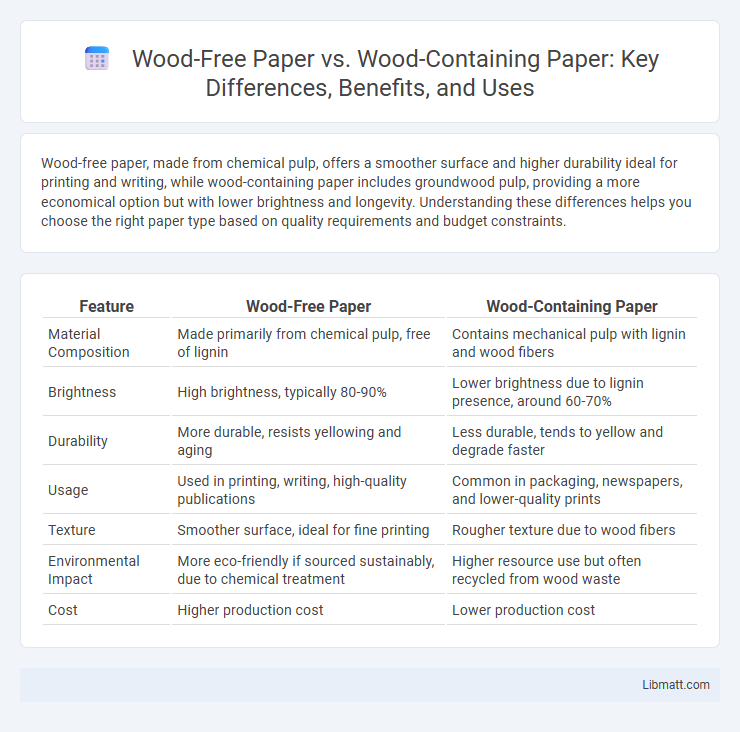Wood-free paper, made from chemical pulp, offers a smoother surface and higher durability ideal for printing and writing, while wood-containing paper includes groundwood pulp, providing a more economical option but with lower brightness and longevity. Understanding these differences helps you choose the right paper type based on quality requirements and budget constraints.
Table of Comparison
| Feature | Wood-Free Paper | Wood-Containing Paper |
|---|---|---|
| Material Composition | Made primarily from chemical pulp, free of lignin | Contains mechanical pulp with lignin and wood fibers |
| Brightness | High brightness, typically 80-90% | Lower brightness due to lignin presence, around 60-70% |
| Durability | More durable, resists yellowing and aging | Less durable, tends to yellow and degrade faster |
| Usage | Used in printing, writing, high-quality publications | Common in packaging, newspapers, and lower-quality prints |
| Texture | Smoother surface, ideal for fine printing | Rougher texture due to wood fibers |
| Environmental Impact | More eco-friendly if sourced sustainably, due to chemical treatment | Higher resource use but often recycled from wood waste |
| Cost | Higher production cost | Lower production cost |
Introduction to Wood-Free and Wood-Containing Paper
Wood-free paper, also known as chemical pulp paper, is produced by removing lignin from wood fibers, resulting in higher durability, brightness, and resistance to yellowing. Wood-containing paper includes mechanical pulp, retaining lignin and other wood components, making it more affordable but prone to faster degradation over time. Choosing between these papers depends on the application, with wood-free preferred for archival quality and wood-containing used for cost-effective printing and packaging.
Understanding Wood-Free Paper
Wood-free paper, despite its name, contains no mechanical wood pulp but is made primarily from chemical pulp, which results in higher purity and durability compared to wood-containing paper. This type of paper offers improved brightness, a smoother surface, and greater resistance to aging, making it ideal for high-quality printing and archival purposes. Understanding your choice between wood-free and wood-containing paper helps ensure the best quality and longevity for your printed materials.
Characteristics of Wood-Containing Paper
Wood-containing paper is produced using mechanical pulp that retains lignin and other wood components, resulting in a coarser texture and lower brightness compared to wood-free paper. It offers higher opacity and better bulk but tends to yellow and deteriorate more quickly due to lignin oxidation. Your choice of wood-containing paper is ideal for applications requiring durability and cost-effectiveness rather than long-term archival quality.
Key Differences Between Wood-Free and Wood-Containing Paper
Wood-free paper is primarily made from chemical pulp, which removes lignin, resulting in higher durability, brightness, and resistance to yellowing compared to wood-containing paper that retains lignin due to mechanical pulping. Wood-containing paper typically has a higher opacity and rougher texture, making it more suitable for packaging and newspapers, while wood-free paper is preferred for high-quality printing and archival documents due to its smooth finish and longevity. The environmental impact also varies, with wood-free paper often requiring more energy-intensive processing but offering better recyclability and longer life span.
Manufacturing Processes Compared
Wood-free paper is primarily manufactured from chemical pulp where lignin is removed during the pulping process, resulting in higher brightness and durability, whereas wood-containing paper uses mechanical pulp that retains lignin, making it less expensive but more prone to yellowing. The chemical pulping process for wood-free paper involves kraft or sulfite methods, enhancing fiber strength and print quality, while mechanical pulping in wood-containing paper relies on grinding or refiner techniques that preserve most wood components. These manufacturing differences directly influence the paper's texture, longevity, and suitability for archival purposes versus mass-market applications.
Print Quality and Durability
Wood-free paper offers superior print quality with smoother surface texture and sharper image reproduction due to its refined pulp composition, making it ideal for high-resolution printing. Its durability is enhanced by resistance to yellowing and brittleness over time, ensuring longer-lasting documents compared to wood-containing paper. When choosing paper for important prints, your selection of wood-free paper can result in clearer visuals and greater longevity.
Environmental Impact and Sustainability
Wood-free paper, made primarily from recycled fibers or non-wood sources like cotton, offers a lower environmental impact by reducing deforestation and conserving natural forests. Wood-containing paper relies on timber harvesting, contributing to habitat loss and higher carbon emissions, but can be made more sustainable through certified forestry practices like FSC or PEFC. Your choice of wood-free paper supports sustainability goals by minimizing resource depletion and promoting circular economy principles in paper production.
Cost Comparison and Market Trends
Wood-free paper, typically made from chemical pulp, commands higher prices due to its superior quality and environmental benefits, whereas wood-containing paper, produced with mechanical pulp, offers a cost-effective alternative favored in high-volume consumer markets. Market trends indicate growing demand for wood-free paper driven by sustainability concerns and stricter environmental regulations, boosting its adoption in premium printing and publishing sectors. Meanwhile, wood-containing paper maintains a strong presence in packaging and newsprint, where cost efficiency remains a critical factor.
Ideal Applications for Each Paper Type
Wood-free paper, composed primarily of chemical pulp, excels in high-quality printing, publishing, and archival documents due to its smooth surface and durability. Wood-containing paper, incorporating mechanical pulp, is best suited for everyday printing, packaging, and newspapers where cost-efficiency and bulk production are priorities. Selecting the appropriate paper type ensures optimal performance based on requirements like print clarity, longevity, and budget constraints.
Choosing the Right Paper for Your Needs
Wood-free paper, typically made from chemical pulp, offers higher brightness, durability, and resistance to yellowing, making it ideal for archival documents and professional printing. Wood-containing paper, produced using mechanical pulp, is more affordable and eco-friendly due to lower manufacturing costs and higher fiber yield, suitable for everyday printing and packaging. Selecting the right paper depends on the intended use, budget constraints, and environmental considerations, balancing quality with sustainability.
Wood-free paper vs wood-containing paper Infographic

 libmatt.com
libmatt.com